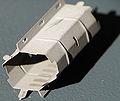EL84
The EL84 is an electron tube with Novalsockel (pressed glass miniature base) and was 1953 by Philips primarily Corporation as a low frequency -End pentode for the application in audio amplifiers developed. In the typing code of the American Radio Electronics Television Manufacturers Association ( RETMA ) it has the designation 6BQ5 . The EL84 / 6BQ5 is still manufactured in various countries today.
General
The EL84 achieves 5.7 watts as a single-ended amplifier in A mode and 17 watts output power as a push-pull amplifier (2 tubes in AB mode ). The anode voltage required for this is 250 to 300 volts, the anode current around 48 mA.
It triggered the 1947 designed 9-W output pentode EL41 from, could emit less power and even the thermal and manufacturing technology rather unfavorable Rimlocksockel (B8A) had.
The EL84 has comparatively small dimensions: with a height of only 72 mm and a diameter of 22 mm, it was possible to a. by designing the electrode system to control the high anode power loss of up to 12 W in the miniature tube bulb - a carefully manufactured EL84 is one of the most reliable power tubes of all, despite the high material loads during operation.
The power tube became particularly well known from the 1960s onwards through its use in the Vox AC15 and AC30 stage amplifiers from the British company Vox .
Equivalents tubes are the 7189 , which was provided with enhanced operating parameters primarily for industrial applications, and the identical, in the USSR prepared 6P14P (Cyrillic: 6П14П ). A slightly modified version of the 6P14P will be manufactured in Russia in 2007 by Sovtek , a company belonging to the New Sensor Corporation , which also manufactures the Mullard tubes. There are also manufacturers in Slovakia , Yugoslavia and China .
Pictures of the EL84
Web links
- frank.pocnet.net - data sheet (PDF file; 382 kB)
Individual evidence
- ↑ VALVO tube pocket book 1965, page 104
- ^ Mullard EL-84







